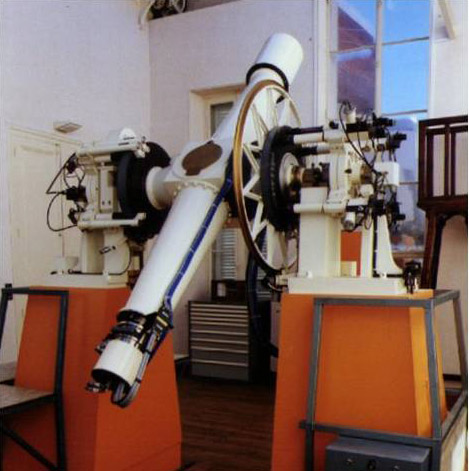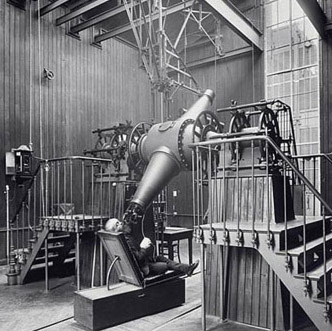
Top
French Academy of sciences
Our partners:
Délégation académique aux arts et à la culture
SAPCB
ESTIA
The castle-museum
City of Hendaye
Oroitza


 Français
Français
The transit circle
The meridian transit
The instrument in Abbadia is a meridian transit circle. Which meridian and which transit?
It can be observed that, unlike conventional telescopes that are motorized and follow the stars
in their diurnal motion, Abbadia's telescope is fixed. It is perpetually facing south. It can just
rotate around an east-west axis and thus observe more or less high in the sky, but still in
the north-south direction. Note that all the stars rise to the east, lie down to the west and culminate
in the direction of the south (except for the stars surrounding the polar star that are still visible).
Thus, the direction of the south is well defined, defining the meridian of the site and it is the passage
or transit in this direction that the telescope will observe: we will measure the moment of the passage
or transit and the height of the star during this passage or transit. From these measurements will be deduced
the positions of the stars on the celestial sphere with more ease and precision than by observing
anywhere with a conventional telescope.

the transit circle observes only in the direction North-South where
the stars culiminate.
Credit Abbadia Archives



from left to right, the transit circle at Besançon, Bordeaux and Nice.
Crédit DR
To know more on astrometry and meridian transit, see
the lesson on astrometry proposed at Abbadia.
The instrument in Abbadia is a meridian transit circle. Which meridian and which transit?
It can be observed that, unlike conventional telescopes that are motorized and follow the stars in their diurnal motion, Abbadia's telescope is fixed. It is perpetually facing south. It can just rotate around an east-west axis and thus observe more or less high in the sky, but still in the north-south direction. Note that all the stars rise to the east, lie down to the west and culminate in the direction of the south (except for the stars surrounding the polar star that are still visible). Thus, the direction of the south is well defined, defining the meridian of the site and it is the passage or transit in this direction that the telescope will observe: we will measure the moment of the passage or transit and the height of the star during this passage or transit. From these measurements will be deduced the positions of the stars on the celestial sphere with more ease and precision than by observing anywhere with a conventional telescope.
